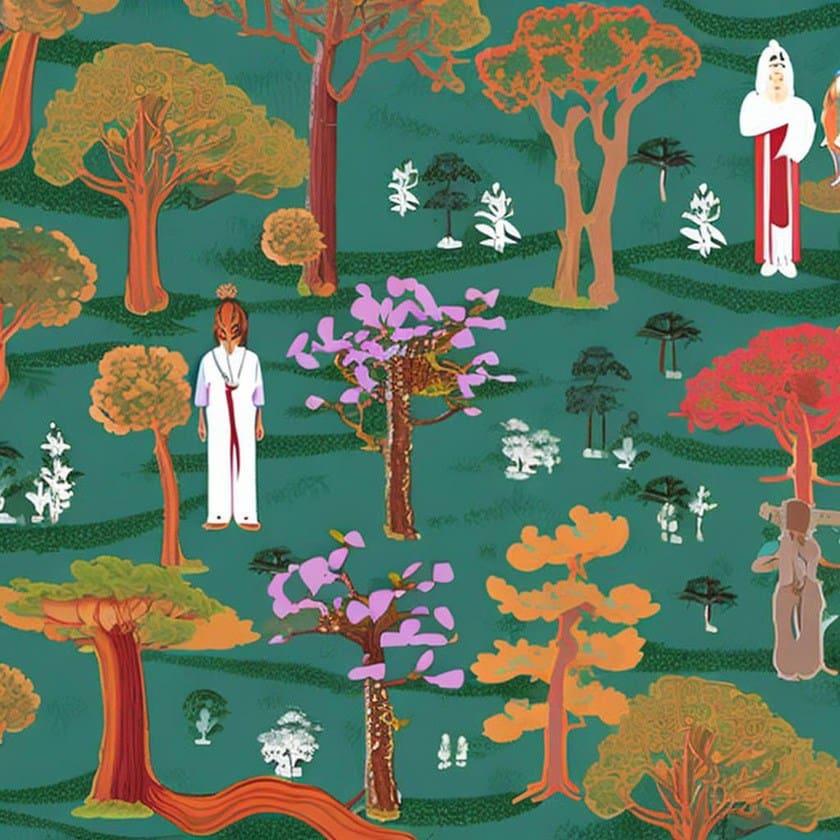Sacred trees in Asia
Sacred trees have played an important role in the cultures and religions of many Asian countries for centuries. These trees are often associated with spiritual significance and are the focus of many rituals and ceremonies.
In many Asian cultures, sacred trees are believed to be the homes of spirits or deities. People may offer food, drink, or other offerings to these spirits as a way of seeking their blessings or protection. Trees are also used as places of worship, and people may gather under the shade of a sacred tree to pray, sing, or perform other religious ceremonies.
In some Asian cultures, certain trees are believed to have healing properties. The bark, leaves, or fruit of these trees may be used to treat a wide range of ailments, from skin conditions to digestive issues. Some of these trees have even been used to create traditional medicines that are still used today.
Sacred trees have also played an important role in the art and literature of many Asian cultures. They are often depicted in paintings, poetry, and other forms of art, and their beauty and symbolism have inspired many artists over the years.
Examples of sacred trees in Asia include the banyan tree, which is considered sacred in many Hindu, Buddhist, and Jain traditions, and the ginkgo tree, which is revered in Chinese culture for its longevity and resilience.
Unfortunately, many of Asia’s sacred trees are at risk due to deforestation, climate change, and other environmental threats. This has led to efforts to protect and preserve these trees, both for their cultural significance and for their ecological value.
Efforts to protect sacred trees in Asia include the establishment of nature reserves, the promotion of sustainable forestry practices, and the education of local communities about the importance of preserving their cultural heritage. By working together to protect these trees, we can ensure that they continue to play an important role in Asian culture for generations to come.
Examples of sacred trees in Asia and their symbolic significance
The Bodhi Tree
The Bodhi tree is a fig tree that is considered sacred in Buddhism and is associated with spiritual awakening and liberation. According to tradition, it was under this tree that the Buddha achieved enlightenment, and it is therefore a symbol of enlightenment and liberation.
The Bodhi Tree, scientifically known as Ficus religiosa, holds profound significance in Buddhism and is revered as a sacred tree across various cultures. Its name, which translates to Tree of Awakening in Pali and Sanskrit, encapsulates its pivotal role in the spiritual journey of the Buddha. The tree is characterized by its heart-shaped leaves, which are often used as a symbol in Buddhist art and teachings, representing clarity of thought and spiritual growth.
According to historical accounts, Siddhartha Gautama, who later became known as the Buddha, meditated beneath the Bodhi Tree in Bodh Gaya, India, for forty-nine days. It was during this period of deep reflection and meditation that he attained enlightenment, gaining profound insights into the nature of suffering, the cycle of birth and rebirth (samsara), and the path towards liberation (nirvana). Thus, the Bodhi Tree is not just a natural monument but a powerful emblem of the potential for all beings to achieve spiritual awakening.
Over the centuries, the Bodhi Tree has also served as a place of pilgrimage for countless Buddhists and seekers from around the world. Temples and monasteries have been built around it, and visitors often come to meditate and reflect on the teachings of the Buddha, finding inspiration in the very spot where enlightenment was attained. The tree is often surrounded by offerings, prayer flags, and incense, as devotees express their reverence and gratitude.
Historically, the original Bodhi Tree under which the Buddha meditated has undergone various challenges, including damage and destruction, but its legacy has been preserved through the planting of its descendants. One notable descendant, located in Bodh Gaya, is regarded as a direct offspring of the original tree and continues to flourish, drawing pilgrims and tourists alike.
Beyond Buddhism, the Bodhi Tree is also recognized in other spiritual traditions. It symbolizes wisdom, compassion, and the interconnectedness of all life, reinforcing the idea that enlightenment is not a solitary endeavor but a communal journey. In this way, the Bodhi Tree stands as a universal symbol of hope, transformation, and the search for deeper meaning in life.
In contemporary society, the Bodhi Tree’s symbolism has transcended religious boundaries, inspiring individuals in various walks of life to seek their own paths to enlightenment, mindfulness, and inner peace. Whether through meditation, nature appreciation, or the pursuit of wisdom, the essence of the Bodhi Tree continues to resonate, inviting all to ponder their own spiritual journeys and the possibility of awakening.
The Pine Tree
The pine tree is considered sacred in many Asian cultures and is associated with longevity, strength, and stability. The tree is often used in traditional medicine and is believed to have spiritual properties that promote health and well-being.
The pine tree, belonging to the genus Pinus, holds a revered place in many Asian cultures, where it is often seen as a symbol of longevity, strength, and stability. These majestic trees can live for hundreds, sometimes even thousands, of years, making them potent symbols of endurance and resilience in the face of adversity. Their evergreen nature adds to this symbolism, signifying eternal life and renewal, as they remain vibrant and lush throughout the seasons while other trees shed their leaves.
In various Asian traditions, the pine tree is frequently associated with auspiciousness and prosperity. It is common to find representations of the pine in art, poetry, and folklore, highlighting its importance in cultural narratives. For example, in Chinese mythology, the pine tree is often featured alongside the crane and the tortoise, all of which are symbols of longevity and good fortune. Together, they embody the ideals of a long, prosperous life, often depicted in traditional paintings and decorations that adorn homes during festive occasions.
The pine tree’s significance extends beyond symbolism; it plays a vital role in traditional medicine across numerous Asian cultures. Various parts of the pine tree, including its needles, bark, and resin, are harvested for their medicinal properties. Pine needle tea, for instance, is rich in Vitamin C and antioxidants, and is believed to promote immune health and overall vitality. In traditional Chinese medicine, pine resin is thought to have healing properties that can alleviate respiratory issues and promote circulation. Additionally, the essential oils derived from pine are often used in aromatherapy for their soothing and invigorating effects, believed to enhance mental clarity and reduce stress.
The spiritual properties of the pine tree are also widely acknowledged. Its strong, upright stature and deep-rooted structure convey a sense of stability and grounding, making it a favored site for meditation and reflection. In many cultures, it is common to find shrines or sacred spaces situated near ancient pine trees, where practitioners seek solace, clarity, and connection to the divine. The tranquil rustle of pine needles in the wind often serves as a meditative backdrop, facilitating a deeper connection to nature and oneself.
In addition to its medicinal and spiritual roles, the pine tree is also an important ecological resource. It provides habitat for various wildlife, contributes to local climate regulation, and plays a crucial role in maintaining biodiversity. The presence of pine forests can enhance soil quality and prevent erosion, further underscoring the tree’s significance as a cornerstone of ecosystems.
In modern times, the appreciation for the pine tree continues to flourish, with a growing recognition of its cultural, medicinal, and ecological value. As people seek connections to nature and sustainable living practices, the pine tree stands as a reminder of the strength inherent in natural systems. Its enduring presence inspires a sense of stability and trust in the cyclical nature of life, encouraging individuals to embrace the virtues of resilience, adaptability, and interconnectedness.
Overall, the pine tree is much more than just a botanical entity; it is a multifaceted symbol of endurance, healing, and harmony that resonates deeply within the cultural fabric of many Asian societies and beyond.
The Banyan Tree
The banyan tree is considered sacred in many Asian cultures and is associated with wisdom, stability, and protection. The tree is often planted near homes and villages as a symbol of protection and is believed to have the power to ward off evil spirits.
The banyan tree, with its expansive canopy and intricate root system, holds a revered place in numerous Asian cultures, often embodying deep spiritual significance. Its towering presence is not merely a testament to its physical beauty but also a symbol of life, endurance, and interconnectedness among communities. In Hinduism, the banyan tree is associated with the divine, particularly with Lord Shiva, representing eternal life and a connection to the cosmos. As such, it becomes a focal point for worship and community gatherings.
In addition to its spiritual associations, the banyan tree serves practical purposes within local communities. Its shade provides a respite from the blazing sun, making it a favorite gathering spot for villagers to socialize, conduct meetings, or even celebrate festivals. The tree’s intricate network of aerial roots, which descend from its branches and take hold in the ground, symbolizes the concept of unity and support, reinforcing the idea that just as the banyan tree thrives through its interconnected roots, so too do communities flourish through their bonds with one another.
Folklore surrounding the banyan tree further enhances its mystical profile. Many cultures believe that residing near a banyan tree brings fortune and security, as it is thought to protect against bad omens and negative energies. Some traditions hold that tying a thread around the tree can invoke blessings or ensure protection for the household. This reverence is often reflected in art, literature, and cultural practices, where the banyan tree is depicted as a guardian that watches over its surroundings.
Moreover, the banyan tree stands as a poignant reminder of the cycle of life and the importance of nurturing the environment. Its longevity, with some trees estimated to be hundreds of years old, serves as an emblem of stability and resilience amidst the ever-changing world. As communities continue to face modern challenges, the banyan tree remains a symbol of hope, reminding individuals to stay grounded and connected to their roots—both literally and metaphorically.
In essence, the banyan tree encapsulates a rich tapestry of cultural meanings, embodying wisdom, stability, and protection while fostering community spirit and environmental awareness. Its enduring legacy continues to inspire reverence and admiration in many regions, serving as a timeless reminder of the harmony between nature and humanity.
The Sakura Tree
The sakura tree, also known as the cherry blossom tree, is considered sacred in Japan and is associated with the cycle of life, renewal, and the fleeting nature of beauty. The blooming of the sakura is a celebrated event in Japan and is associated with the arrival of spring.
The sakura tree, or cherry blossom tree, holds a special place in Japanese culture, symbolizing not only beauty but also the poignant transience of life. With its delicate pink and white blossoms that bloom for a short period each spring, the sakura embodies the concept of mono no aware, a Japanese term that captures the bittersweet appreciation of the ephemeral nature of beauty and existence. This philosophy emphasizes the idea that beauty is heightened by its impermanence, making each fleeting moment all the more precious.
As winter gives way to spring, the blooming of the sakura marks a much-anticipated seasonal transition. Hanami, the traditional practice of enjoying the transient beauty of flowers, draws people outdoors for picnics and gatherings under the blooming sakura trees. Parks and gardens become vibrant festivals of color and joy as families and friends come together to celebrate the arrival of warmer weather. This cultural phenomenon not only fosters a sense of community and togetherness but also encourages a deep appreciation of nature’s cycles.
The significance of the sakura extends beyond its aesthetic appeal. Historically, cherry blossoms have been used as symbols of resilience and renewal. In various Japanese traditions, they represent the fleeting nature of life, often aligning with the samurai ethos, where life is viewed as a beautiful but short-lived journey. This symbolism resonates deeply within Japanese literature, art, and even modern media, reinforcing the idea that life, like the cherry blossoms, is beautiful yet transient.
Sakura trees are often planted near temples and shrines, and they play a role in numerous festivals throughout the year. The cherry blossom motif is prevalent in cultural artifacts, including clothing, ceramics, and artwork, making it a fundamental element of Japanese identity. The beloved sakura also inspires various culinary delights, such as sakura mochi (sweet rice cakes wrapped in cherry blossom leaves) and sakura-flavored treats, bringing the essence of the blossoms into the realm of gastronomy.
As globalization spreads, the allure of the sakura has transcended Japan’s borders, captivating hearts around the world. Cherry blossom festivals are now celebrated in many countries, each interpreting and honoring this symbol of beauty and renewal in unique ways. This international appreciation further affirms the sakura’s universal themes of hope and the celebration of life’s fleeting moments.
In essence, the sakura tree is much more than just a beautiful floral spectacle; it serves as a profound reminder of the cycles of nature, inviting reflection on the transient beauty of life. The cherry blossom’s annual bloom is a celebration of renewal, prompting individuals to cherish moments of beauty, community, and connection—reminders to embrace life’s fleeting yet precious nature. The sakura, with its delicate petals and rich symbolism, continues to inspire and resonate deeply both in Japan and across the globe.
The Peepal Tree
The peepal tree is considered sacred in Hinduism and Buddhism and is associated with protection, wisdom, and spiritual awakening. The tree is often planted near homes and temples as a symbol of protection and is believed to have the power to ward off evil spirits.
The peepal tree, also known as the sacred fig or Ficus religiosa, holds profound spiritual significance in both Hinduism and Buddhism. Revered for its majestic stature and broad, heart-shaped leaves, the peepal tree is often viewed as a bridge between the earthly and the divine. Its rich symbolism encompasses protection, wisdom, and spiritual awakening, making it a cherished presence in various cultures throughout South Asia.
In Hindu tradition, the peepal tree is often associated with Lord Vishnu, the preserver in the Hindu trinity, and is believed to embody the essence of life and renewal. It is considered an auspicious tree that brings prosperity and tranquility to those who reside near it. Because of this, many households plant peepal trees close to their homes or gardens, believing that they create a protective aura that wards off negativity and evil spirits. The mere sight of this venerable tree is thought to inspire divine blessings and safeguard the family.
Similarly, in Buddhism, the peepal tree holds special significance as it is said to be the tree under which Siddhartha Gautama attained enlightenment and became the Buddha. This event marks a pivotal moment in spiritual history, symbolizing the quest for knowledge and the awakening of higher consciousness. As a result, the peepal tree is often planted near Buddhist temples and meditation centers, serving as a living reminder of enlightenment and the pathway to inner peace. Pilgrims and practitioners often gather beneath its branches to meditate, seeking inspiration and solace in the tranquility that the tree offers.
The peepal tree is also celebrated for its ecological benefits. Known for its ability to release oxygen even at night, it contributes to the local environment by improving air quality and providing shade. This connection to nature reinforces the belief that the peepal tree is a nurturing presence, embodying the idea of harmony between humanity and the natural world. Its deep roots and expansive canopy echo the interconnectedness of all living beings, highlighting the importance of respecting and protecting the environment.
Culturally, the peepal tree has inspired a wealth of folklore, art, and poetry. Many stories describe its wisdom, often portraying the tree as a silent witness to the passage of time and the unfolding of human experiences. In Indian architecture, the peepal is often artistically represented in sculptures and murals, symbolizing the divine companionship between humanity and nature. Its leaves, with their unique shape and vibrant green hue, are frequently utilized in religious ceremonies and offerings.
Moreover, the peepal tree serves as a gathering point for communities, fostering social bonds and collective spirituality. During festivals and special occasions, people come together to celebrate under its boughs, reinforcing the communal aspect of devotion and gratitude. This tree, revered for its spiritual symbolism and community-building potential, plays a vital role in cultural practices and rituals.
In essence, the peepal tree is not merely a botanical entity but a sacred symbol steeped in meaning and reverence. It represents a sanctuary of wisdom, protection, and spiritual awakening, inviting individuals to reflect on their beliefs and fostering a sense of community. As a powerful emblem of resilience and life, the peepal tree continues to inspire reverence across generations, serving as a testament to the enduring connection between nature and spirituality.
These are just a few examples of the many sacred trees found in Asia, each with its own unique symbolism and significance. For many Asian cultures, trees are seen as living beings with their own spirits, and their presence and protection is considered essential for the well-being of the community.
Shop tip
Sacred trees in Asia On Amazon

Thank you for likes, shares and comments! 🌳🌴🌲🌵
Source OpenAI’s chatGPT Language Models, Dalle, AI trot and Fleeky
images Picsart and MIB
Embark on your journey in affiliate marketing and website creation alongside an incredible community and myself. Invest in your future by dedicating time to learn and earn. Take all the time you need to master the basics before aiming higher. Give it a try—you won't regret it! Discover the possibilities for yourself...


